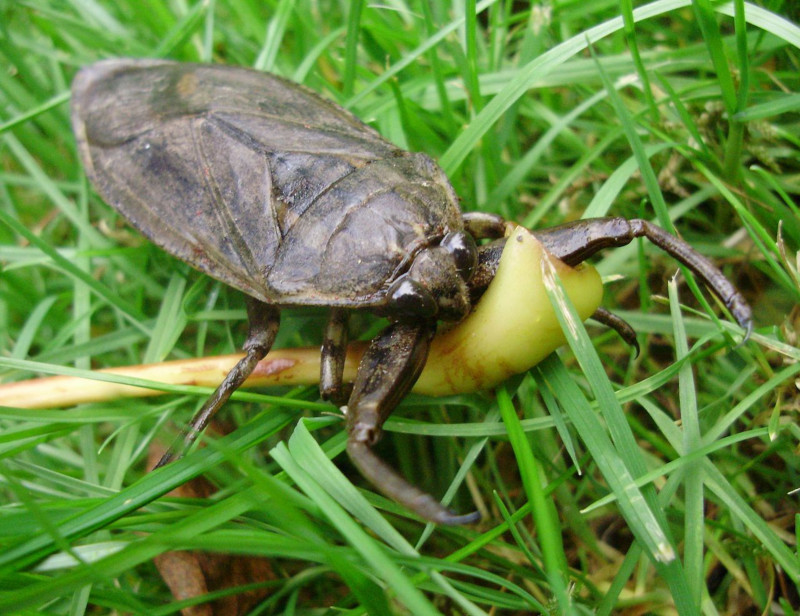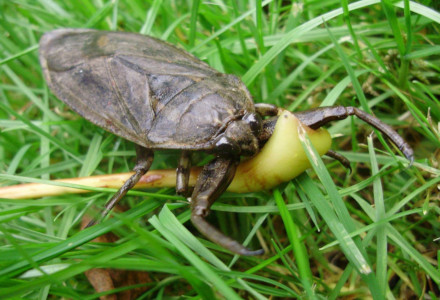
Giant Water Bug Facts
- The highly evocative term of Giant Water Bug quite accurately serves as one of the common names for this relatively large insect. This behemoth of its kind also goes by the humorous, though equally accurate, common name of the toe-biter.
- Its official scientific name, meanwhile, remains that of the somewhat informative, though hard to pronounce Lethocerus americanus. By either of these names, though, the creature remains a most fascinating, if visually unappealing, insect.
- The first recorded official scientific identification of this remarkable invertebrate further took place in the year 1847. This noteworthy event occurred as a direct result of the work of the highly respected American scientist and researcher, Joseph Leidy.
- For the moment, the amazing arthropod appears to still be present in relative abundance throughout its range. The IUCN, therefore, currently has no status listed for it. Any such listing would appear on the organization’s Red List of Threatened Species.
- The, to some, intimidating Giant Water Bug, must, nevertheless, be considered to facing at least some risks to it as a species. Habitat loss remains a potential danger. Its greatest threat, though, most likely consists of the effects of ongoing climate change.
Related Articles
Giant Water Bug Physical Description
In the specific case of the awesome Giant Water Bug, its name remains completely appropriate. That’s due to the simple fact that this arthropod ranks as a true giant of its kind. It also, differently from many insects, shows no noticeable sign of sexual dimorphism.
As a natural consequence of this fact, mature adult specimens of this insect attain the same impressive size. On average, these reach body lengths between 1.5 – 2.4 in (4 – 6.2 cm). That same body, though, also develops as extremely flattened in structure.
These creatures further display a somewhat oval shape, in addition to the flat body design. In coloring, this member of the Hemiptera Order also displays a color scheme consisting of various shades of brown. The lone exception remains the enormous black eyes.
The rear four of the legs of the Giant Water Bug evolved a comparatively flattened shaped, like the rest of the body. In this case, though, this serves to aid it in swimming. The out-sized, and quite powerful, front legs, evolved into pincers, remain its most notable feature.
- Kingdom: Animalia
- Phylum: Arthropoda
- Class: Insecta
- Order: Hemiptera
- Family: Belostomatidae
- Genus: Lethocerus
- Species: L. americanus
Giant Water Bug Distribution, Habitat, and Ecology
Quite fortunately for it, the impressive Giant Water Bug inhabits a comparatively large area of the world. This holds especially true for an insect of its kind. In point of fact, it appears naturally in an area covering much of the continent of North America.
More precisely, it lives in a region that begins with the southern portions of Canada. The majority of that range, though, further covers the entirety of the continental United States. Its greatest concentration, though, appears in the south and southeast sections.
Its very name contains also contains a reference to its habitat preferences. This arthropod shows great flexibility in this, however. It appears to be equally at home in regions consisting of creeks, streams, marshes, ponds, and even the outlying edges of lakes.
The Giant Water Bug further evolved as entirely carnivorous in nature, like many of its relatives. In this respect, evolution created a formidable predator. It generally preys on similar sized creatures, but will also attack prey slightly larger than itself on occasion.
This prey most commonly includes such forms of life as various small species of fish, snails, frogs, and newts. It will, nonetheless, sometimes choose to attack and feed on small snakes. Each of these it grabs with those powerful pincers, and pulls it to its fate.
Species Sharing Its Range
Check out our other articles on 4 Bulgarian Geological Marvels, Bee Hummingbird, Namib Desert, Muhure, Woylie, Giant Oarfish, Flatback Sea Turtle, Purple Frog

